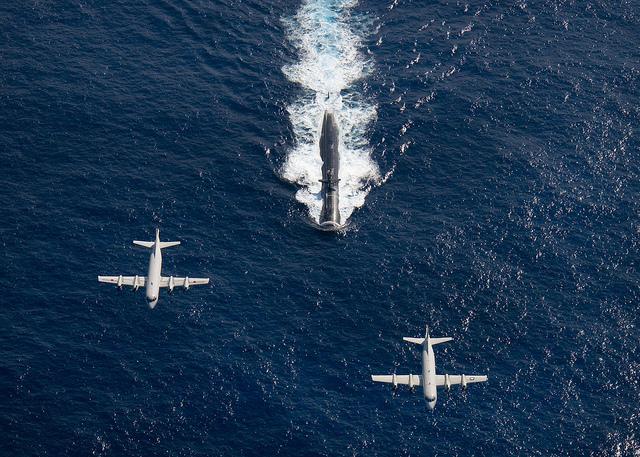Australia and the Freedoms of Navigation
Posted By Sam Bateman on June 5, 2015 @ 10:53
Ringed as we are by archipelagos, freedoms of navigation and overflight (FON) are extremely important to Australia.
The archipelagic sea lanes (ASL) passage introduced by the UN Convention on the Law of the Sea (UNCLOS) guarantees the non-suspendable right of ships and aircraft to transit through the waters of an archipelagic state, such as Indonesia, Papua New Guinea and the Philippines, provided they use ASLs designated by the archipelagic state. Or, if no such lanes have been designated, transit is allowed along routes normally used for international navigation or overflight.
Only Indonesia [2] has so far designated ASLs. However, these are just a partial designation as the designated ASLs only provide for a north-south transit and there is no east-west sea lane through the Java and Flores seas. Because this is a route normally used for international navigation, Australia, the US and possibly other countries continue to exercise their right of ASL passage through these seas, although this appears contrary to Indonesian regulations.
Unlike the US, Australia doesn’t have a formal FON program, and we rarely follow the US example of formally protesting ‘excessive claims’ to maritime jurisdiction. The US is the only country in the world with a formal FON program. It has three elements: bilateral and multilateral consultations with other governments that may be planning new claims regarded as contrary to international law; diplomatic representations and protests; and operational assertions of rights by US military units. The philosophy of the US FON program is that if claims and constraints aren’t challenged, they may over time be considered accepted by the international community
During the fiscal year 2014, the US conducted operational assertions [3] to challenge excessive maritime claims by the following regional countries: China, India, Indonesia, Iran, Malaysia, Maldives, Philippines, Sri Lanka, Taiwan and Vietnam. The claims by Indonesia challenged by the US included the partial designation of archipelagic sea lanes, and the requirement for prior notification by foreign warships to enter Indonesia’s territorial sea and archipelagic waters.
According to the US Maritime Claims Reference Manual [4], three claims made by Australia have been protested by the US. These include Australia’s establishment of territorial sea straight baselines and declaration of Anxious, Encounter, Lacepede and Rivoli Bays as historic bays. The US doesn’t recognise these claims and has lodged a diplomatic protest against them. However, while the US routinely conducts FON operations against historic bays elsewhere in the world, it has not undertaken them against the bays claimed by Australia. Secondly, the US has protested Australia’s claim to an EEZ around the Australian Antarctic Territory.
Australia’s final disagreement with the US on FON is our introduction in 2006 of compulsory pilotage [5] through the Torres Strait and the Great Northeast Channel. This regime doesn’t apply to ships with sovereign immunity, but due to difficulties of navigation in the area, USN vessels still routinely take pilots for the passage of the strait. However, in requesting a pilot, a USN ship will note the ‘request is voluntary and not based on the mandatory pilotage scheme’.
A noteworthy FON incident involving Australia and China occurred in 2001.
A Chinese warship challenged three Australian navy ships [6] in the Taiwan Strait heading from South Korea to Hong Kong. The incident occurred about two weeks after a Chinese fighter jet collided with an American spy plane over the South China Sea, sparking diplomatic tensions between Beijing and Washington. The Australian vessels apparently declined to change course, saying they were exercising their right to freedom of navigation in accordance with UNCLOS.
The Australian Government is now believed to be planning a so-called ‘freedom of navigation’ exercise [7], which would involve an Australian P-3 Surveillance aircraft flying very near artificial islands being built by China in the South China Sea. While RAAF P-3 aircraft have conducted surveillance flights over the South China Sea for decades it isn’t clear what this latest gesture aims to achieve other than being a provocation to China. Australia’s direct national interests aren’t involved with overflight in the South China Sea in the same way as they are with navigation and overflight through the archipelagos to our near North.
Furthermore, China hasn’t made clear which restrictions on navigation and overflight it’s imposing around features it occupies in the South China Sea. When and if it does issue such restrictions, then a diplomatic protest by Australia would be more appropriate than ‘jumping the gun’ now and flying aircraft into a messy legal situation. As well as provoking China, that gesture would be seen in the region as Australia simply acting once again as a ‘deputy sheriff’ to the US in the region.
Article printed from The Strategist: https://aspistrategist.ru
URL to article: /australia-and-the-freedoms-of-navigation/
URLs in this post:
[1] Image: https://aspistrategist.ru/wp-content/uploads/2015/06/5258362780_56bdb0ccb8_z.jpg
[2] Only Indonesia: https://www.navy.gov.au/spc/publications/semaphore/semaphore-2005-issue-6
[3] US conducted operational assertions: http://policy.defense.gov/OUSDPOffices/FON.aspx
[4] US Maritime Claims Reference Manual: http://www.jag.navy.mil/organization/code_10_mcrm.htm
[5] 2006 of compulsory pilotage: https://www.navy.gov.au/spc/publications/semaphore/semaphore-2007-issue-7
[6] Chinese warship challenged three Australian navy ships: http://news.bbc.co.uk/2/hi/asia-pacific/1303037.stm
[7] ‘freedom of navigation’ exercise: http://www.abc.net.au/radionational/programs/breakfast/government-reportedly-planning-freedom-of/6513778
Click here to print.
